
Si Jagur or Ki Jagur is an old cannon of Portuguese heritage which is located in the Jakarta Fatahillah Museum.

Si Jagur or Ki Jagur is an old cannon of Portuguese heritage which is located in the Jakarta Fatahillah Museum.

Si Jagur cannon was made by a Portuguese named Manoel Tavares Baccaro in Macau, China, which was then brought by the Portuguese to Melaka, In Macau, this cannon was placed by the Portuguese in the fortress of St. Jago de Barra (St. Jago = the name of a saint, de Barra = near the beach, therefore it was called "Si Jagur"). [1]
Si Jagur was transferred from Macau to Malacca at some time in the 16th century. It was brought to Batavia by the Dutch after capturing Malacca in 1641. At first the VOC cannon was placed in Batavia Fortress, to guard the port. Then it was moved to an artillery magazine near Tongkol street. [2]
It is also said that Si Jagur has a "twin", the Ki Amuk cannon belonging to the Sultanate of Banten, which is currently in the courtyard of the Banten Grand Mosque. Si Jagur has a length of 3.85 m (12.6 ft) and a caliber of 25 cm (9.8 in). The weight of the cannon is 3.5 t (3.4 long tons; 3.9 short tons). [1]

According to Voyage Autour du Monde by Ludovic Marquis de Beauvoir, the cannon was brought to its position (about 2 mi (3.2 km) from Batavia's shore) by some extraordinary tide. Malay women come and settle accounts with the tutelary deity of this gun, and pray for children. The Malays surrounded it and offering incense as well as baskets full of flowers, and the heads of fighting cocks are cut off before it. [3]
The shape of the hand is good luck or warning off evils. This thumb shape is called "mano fico" or "mano figa" in Portuguese. [4] Some people believed that the cannon had special powers and could help with fertility. [5]

Banten is the westernmost province on the island of Java, Indonesia. Its capital city is Serang and its largest city is Tangerang. The province borders West Java and the Special Capital Region of Jakarta on the east, the Java Sea on the north, the Indian Ocean on the south, and the Sunda Strait on the west and shares a maritime border with Bengkulu and Lampung to the east and Bangka Belitung Islands to the north. The province covers an area of 9,352.77 km2 (3,611.12 sq mi). It had a population of over 11.9 million in the 2020 census, up from about 10.6 million in 2010. The estimated mid-2023 population was 12.308 million. Formerly part of the province of West Java, Banten was split off to become a province on 17 October 2000.
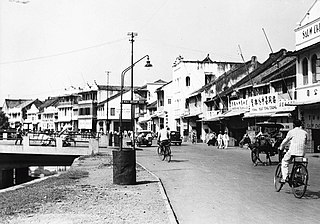
Batavia was the capital of the Dutch East Indies. The area corresponds to present-day Jakarta, Indonesia. Batavia can refer to the city proper or its suburbs and hinterland, the Ommelanden, which included the much larger area of the Residency of Batavia in the present-day Indonesian provinces of Jakarta, Banten and West Java.

Nasi uduk is an Indonesian-style steamed rice cooked in coconut milk dish, especially popular in Betawi cuisine.

The Mardijker people refer to an ethnic community in the Dutch East Indies made up of descendants of freed slaves. They could be found at all major trading posts in the East Indies. They were mostly Christian, of various ethnicities from conquered Portuguese and Spanish territories, and some with European ancestry. They spoke Mardijker Creole, a Portuguese-based creole, which has influenced the modern Indonesian language.
Betawi, also known as Betawi Malay, Jakartan Malay, or Batavian Malay, is the spoken language of the Betawi people in Jakarta, Indonesia. It is the native language of perhaps 5 million people; a precise number is difficult to determine due to the vague use of the name.

The Lantaka also known as rentaka was a type of bronze portable cannon or swivel gun, sometimes mounted on merchant vessels and warships in Maritime Southeast Asia. It was commonly equipped by native seafaring vessels from the Philippines, Indonesia, Brunei, and Malaysia. Lela and rentaka are known by the Malays as meriam kecil, the difference is that rentaka is smaller in length and bore than a lela. and Lantakas are often called Kanyon in Filipino.

The Banten Sultanate was a Bantenese Islamic trading kingdom founded in the 16th century and centred in Banten, a port city on the northwest coast of Java; the contemporary English name of both was Bantam. It is said to have been founded by Sunan Gunungjati, who had previously founded Cirebon.
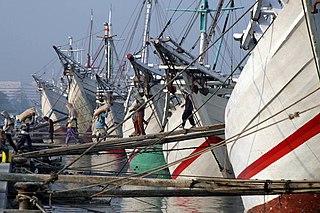
Sunda Kelapa is the old port of Jakarta, located on the estuary of the Ciliwung River. "Sunda Kalapa" is the original name, and it was the main port of the Sunda Kingdom. The port is situated in Penjaringan District, of North Jakarta, Indonesia. Today the old port only accommodates pinisi, a traditional two-masted wooden sailing ship providing inter-island freight service in the archipelago. Although it is now only a minor port, Jakarta has its origins in Sunda Kelapa and it played a significant role in the city's development. The port is currently operated by the state-owned Indonesia Port Corporations.

Company rule in the Dutch East Indies began when the Dutch East India Company appointed the first governor-general of the Dutch East Indies in 1610, and ended in 1800 when the bankrupt company was dissolved and its possessions were nationalized as the Dutch East Indies. By then it exerted territorial control over much of the archipelago, most notably on Java.

The Jakarta History Museum, also known as Fatahillah Museum or Batavia Museum, is located in the Old Town of Jakarta, Indonesia. The building was built in 1710 as the Stadhuis of Batavia. Jakarta History Museum opened in 1974 and displays objects from the prehistory period of the city region, the founding of Jayakarta in 1527, and the Dutch colonization period from the 16th century until Indonesia's Independence in 1945.

Benteng people are a Chinese Indonesian community of 'Peranakan' or mixed descent, native to the historic Tangerang area in the modern-day Indonesian provinces of Jakarta, Banten and West Java.
Preman is a term for Indonesian organized crime groups, encompassing street level criminals up through crime bosses. Premans are often perceived negatively throughout Indonesian society due to associations with violence and criminality. This root word is derived from a term which describes the "confluence of state power and criminality". However, organized crime in Indonesia has a more enduring and complicated history, as the confluence of crime syndicates with perceived legitimate political authority has a history extending as far back as the Mataram Kingdom. While associated with brigandage and theft, Indonesian crime syndicates have periodically acted as enforcers to maintain authority and order. The roles of the jago or jawara were particularly important during the Indonesian Revolution, as they often adopted political roles that helped consolidating the power of local authorities. Despite their significance to Indonesian history, syndicates are universally marginalized due to associations with violence and social illegitimacy.
Portuguese Indonesians are native Indonesians with Portuguese ancestry or have had adopted Portuguese customs and some practices such as religion.
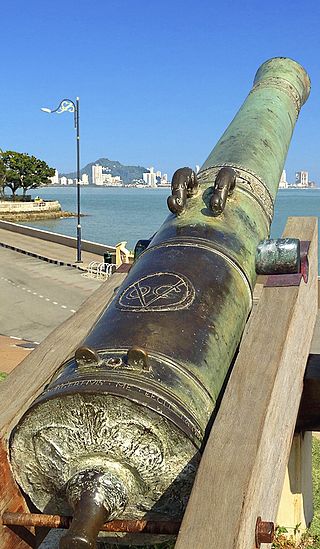
The Seri Rambai is a seventeenth-century Dutch cannon displayed at Fort Cornwallis in George Town, the capital city of the Malaysian state of Penang and a UNESCO World Heritage Site. It is the largest bronze gun in Malaysia, a fertility symbol and the subject of legends and prophecy.
Cetbang were cannons produced and used by the Majapahit Empire (1293–1527) and other kingdoms in the Indonesian archipelago. There are 2 main types of cetbang: the eastern-style cetbang which looks like a Chinese cannon and is loaded from the front, and the western-style cetbang which is shaped like a Turkish and Portuguese cannon, loaded from the back.

The djong, jong, or jung is a type of sailing ship originating from Java that was widely used by Javanese, Sundanese, and later, also by Peguan, Malay, and East Asian sailors. The word was and is spelled jong in its languages of origin, the "djong" spelling being the colonial Dutch romanization. In English, the djong lends its name to other ships of similar configuration, called junks, and to their characteristic style of rigging, the junk rig.
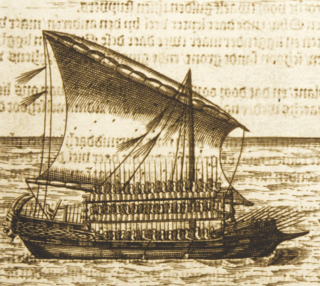
Ghali, gali, or gale are a type of galley-like ships from the Nusantara archipelago. This type of ship only appeared after the 1530s. Before the appearance of this type of ship, several native galley-like ships already existed in the archipelago, some with outriggers. The design of ghali is the result of the impact made by Mediterranean shipbuilding techniques on native shipbuilding, introduced particularly by Arabs, Persians, Ottoman Turks, and Portuguese. The terms may also refer to Mediterranean vessels built by local people, or native vessels with Mediterranean influence.

Ki Amuk is an ancient cannon belonging to the Sultanate of Banten, which is currently located in front of the Grand Mosque of Banten, Banten Province, Indonesia. Ki Amuk cannon was used to protect the Karanghantu Port in Banten Bay.

Lela or lila is a type of Malay cannon, used widely in the Nusantara archipelago. They are similar to a lantaka but longer and had larger bore. Lela can be configured as swivel gun, fixed gun, or mounted in a gun carriage. It is the equivalent of European falcon and falconet.
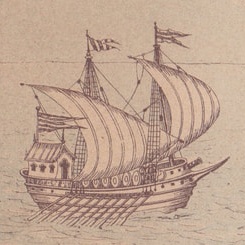
Mendam Berahi was a legendary royal galley said to have been used by the Malacca Sultanate in the early 16th century. This ship is fictional, recorded in the epic Hikayat Hang Tuah, and that type of ship, the ghali, did not exist until after the 1530s.
![]() Media related to Si Jagur Cannon at Wikimedia Commons
Media related to Si Jagur Cannon at Wikimedia Commons